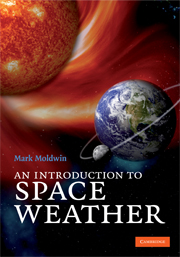Book contents
- Frontmatter
- Contents
- Preface
- Acknowledgments
- 1 What is space weather?
- 2 The variable Sun
- 3 The heliosphere
- 4 Earth's space environment
- 5 Earth's upper atmosphere
- 6 The technological impacts of space storms
- 7 The perils of living in space
- 8 Other space weather phenomena
- Appendix A Web resources
- Appendix B SI units
- Appendix C SI prefixes
- References
- Historical bibliography
- Index
- Plate section
4 - Earth's space environment
Published online by Cambridge University Press: 05 June 2012
- Frontmatter
- Contents
- Preface
- Acknowledgments
- 1 What is space weather?
- 2 The variable Sun
- 3 The heliosphere
- 4 Earth's space environment
- 5 Earth's upper atmosphere
- 6 The technological impacts of space storms
- 7 The perils of living in space
- 8 Other space weather phenomena
- Appendix A Web resources
- Appendix B SI units
- Appendix C SI prefixes
- References
- Historical bibliography
- Index
- Plate section
Summary
It has now become possible to investigate the region above the ionosphere in which the magnetic field of the earth has a dominant control over the motions of gas and fast charged particles … it may appropriately be called the magnetosphere.
T. Gold from the paper that coined the term magnetosphere (J. Geophys Res., 64, 1219–1224, 1959). From the American Geophysical Union.Key concepts
magnetic field
magnetosphere
Van Allen radiation belt
magnetic reconnection
geomagnetic storm
Introduction
At approximately 100 km (or about 60 miles) above Earth's surface, the amount of ionized gas becomes appreciable. Because ionized gas is electrically charged, it feels the effect of Earth's magnetic field, which plays an important role in guiding the motion of charged particles in near- Earth space. Through its interaction with the magnetized solar wind, Earth's magnetic field is intimately involved in coupling or transferring of energy and momentum from the Sun into our space environment. This chapter describes the magnetic field region surrounding Earth called the magnetosphere. The connection of the magnetosphere with the Sun is at the heart of space weather.
Dipole magnetic field
Magnetic fields are force fields around magnets, electric currents, or moving charged particles that exert a force on other magnets, electric currents, or moving charged particles. Due to the motion of molten iron inside Earth, a relatively strong magnetic field surrounds it.
- Type
- Chapter
- Information
- An Introduction to Space Weather , pp. 50 - 67Publisher: Cambridge University PressPrint publication year: 2008

